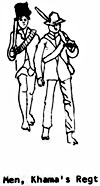I. Figures:
As stated in the article about the Matabele campaign, the Matabele were an offshoot of the Zulus. A period engraving shows Lobengula and several warriors wearing some sort of black ostrich feather headgear and a short black cowtail fringe. For gaming purposes, players may use Zulu figures without much worry about inaccuracy. For safety concerning the headgear, gamers may opt to use figures which only wear headrings or have no headgear at all. Most Matabele should be armed with assegais, although a few may have knobkerries or rifles.
Photos of officers from the BBP and BSACP show a uniform not too dissimilar from that of the Zulu era Frontier Light Horse. The major differences were as follows:
| FLH | BSACP/BBP | |
|---|---|---|
| Boots Hat |
topped above the knee turned up at front |
topped at knee turned up at side (if at all) |
A sketch by Woodville also shows three policemen wearing sun helmets. Civilian volunteers, such as Raaf's recruits were probably non-descript as far as dress was concerned. Thus, for gaming, Zulu War Frontier Light Horse should probably suffice, if a bit inaccurate, for the police. A few men wore puttees and sun helmets, so a few British Camel Corps troopers, or any figures similarly attired and equipped with bandoliers, can also be thrown into the force. For the civilian volunteers, Boer figures will probably do. Just remember that the BBP and the BSACP were armed with Martini-Henrys and Henry repeaters (as were the civilians).
The real catches are the Mashona Warriors who accompanied the Victoria Column and Khama's Regiment, which was part of the Imperial Column. I haven't seen any really good photos or drawings of Mashona warriors from this period or from the 1896 Matabele-Mashona Rebellion. I suppose that they could be symbolically represented by NNC figures (very few or no rifles). I have also never seen any really accurate figures from Khama's troops, although Falcon's Hereros might be sufficient.
II. Rules Modifications:
For all practical purposes, the Matabele may be treated as Zulus. The BBP and BSACP were officers and had NCO's from the regular service and thought of themselves in terms of "The Regiment". They should be treated as mounted infantry for movement and morale. Ordinarily, the civilians might have been treated as green troops, but the men who rode with Jameson were ruthless, as their actions following the action on the Imbembesi indicated. They should be treated as M.I. for movement and morale.

Although they were badly chopped up on the Shangani, the Mashonas generally gave good service on the campaign. They should be treated as NNC but with better morale. Khama's Regiment also performed well, but briefly, with the Imperial Column. They should be treated as Mashonas, but should be armed with rifles and not spears. The Black contingents should all be on foot The automatic weapons carried by the columns were Maxim guns, so rules governing these "advanced" machine guns should be used.

When in laager and when playing the Company Column, only Whites may fight within the compound. The Mashonas have to take their chances outside. For terrain ideas, see any NATIONAL GEOGRAPHIC articles about Rhodesia or Simbabwe.
Finally a word on scale. At the Shangani, the Company Column was outnumbered 6 to 1 and on the Imbembesi, it was outnumbered 9 to 1. When playing SOTQ, there should be a minimum of 3 Matabele for every British. When using a scale of 1:25, there should be 10 BSACP, 4 Civilians, and 16 Mashona vs 200-300 Matabele. At 1:10, 25 BSACP, 10 Civilians, and 40 Mashona should be opposed by 500-700 Matabele. When working on a massive scale, such as Hal's Isandhlwana project, the Matabele can be represented on a 1:2 scale with 2500 figures. At the same ratio, the Company Column would consist of 120-125 BSACP, 50 Civilian Volunteers, and 200 Mashona. The column also has several Maxims and possibly a cannon or two.
Editor's Note: I'd like to thank Paul for these two fine articles. He had first of all sent me the first article and I asked him to write something additional on wargaming the period, which he kindly did. If Paul is interested, perhaps we can get together at some point in the future and put on a game with my Zulu figures and his scenario. Please let me know Paul.
Back to MWAN #19 Table of Contents
Back to MWAN List of Issues
Back to Master Magazine List
© Copyright 1986 Hal Thinglum
This article appears in MagWeb (Magazine Web) on the Internet World Wide Web.
Other military history articles and gaming articles are available at http://www.magweb.com